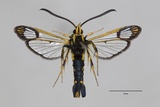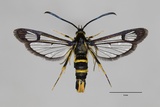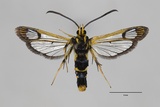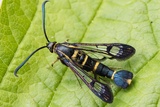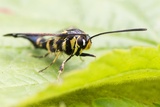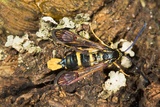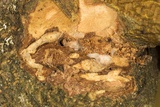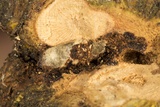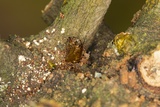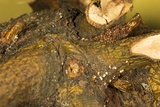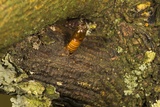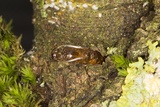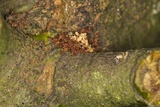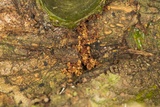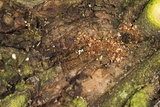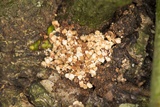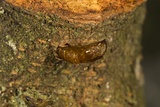Synanthedon loranthi (Králíček, 1966) Species
Last modified: Nov. 27, 2025, 5 p.m.
This species was found new to Belgium in 2019 in the Gaume region (LX). Hitherto is a local and rare species in the extreme south of Belgium where Viscum album is present. From 2022 onwards, it was also found in the other Belgian provinces except for WV.
Data Deficient due to a lack of sufficient data according to the IUCN Red List category for Flanders 2023.
Details
- Classification
- Family: Sesiidae > Subfamily: Sesiinae > Tribus: Synanthedonini > Genus: Synanthedon > Species: Synanthedon loranthi
- Vernacular names
- Maretakwespvlinder (NL), Mistletoe Clearwing (EN), La Sésie du Gui (FR), Mistel-Glasflügler (DE)
- First mention in Belgium
- Garrevoet Theo 2020. Synanthedon loranthi (Lepidoptera: Sesiidae), een nieuwe wespvlindersoort voor België. — Phegea 48(4): 98-102. On page 98. view page
- Status
-
Native
Distribution
Imago
S. loranthi is a relatively small to medium-sized species (15–22 mm) and has brown-black forewings with some yellow scales along the leading edge and a variable amount of yellow scales between the veins of the apical field. The outer transparent field (ETA) is quite large and consists of 5 cells. The fore coxa is laterally up to 2/3 of its lenght yellow colored. The antennae are black as are the palps, which are ventrally bright yellow. The yellow pericephalic hairs form a clearly contrasting collar. The tegulae on the thorax are also clearly yellow edged. The abdomen is black with often a violet hue and has yellow bands on segments 2 and 4 and often also a narrow band on segment 6. In the male there is also a yellow band on segment 7 and the abdominal brush is black with centrally clear yellow hair scales while in the female this brush is strikingly yellow with black hair scales on the sides. So, there is a clear sexual dimorphism.
The proboscis is, as in all species of this genus, well developed and functional.
The males are very rarely attracted to pheromones of variable composition but seem to be best lured in late afternoon. But, as always, the optimal time span is very weather dependent. Attracted to species-specific pheromone and Synanthedon vespiformis among others.
Egg
The eggs are elliptically shaped and red-brown.
Caterpillar
The larva is off-white, has a dark-brown head that turns paler distally and a yellow-brown prothoracic shield. As in all Sesiidae, the prolegs have a double wreath of small hooks.
Bionomics
The female lays eggs at the base of the semi-parasitic plant Viscum album (mistletoe). This plant causes swellings at its base in various species of trees and shrubs. Usually, well-sunlit mistletoe high up in the host is preferred. The young caterpillar then burrows into the plant and lives in the transition zone of the mistletoe and its host between wood and bark in a short gallery where it feeds on plant sap. The extruded frass is usually grainy and reddish-brown, but sometimes it is much lighter in colour. This colour difference may be due to the origin of the frass: reddish brown if it comes from the host plant – which can also be different– and light yellow if it comes from the mistletoe as the caterpillar regularly builds a gallery in the mistletoe itself. Later, the corridor is often extended to a flat, often oval mine. In winter and early spring, with hardly any larval activity, there is usually no frass at all. In many cases it is also washed away by rain or blown away by the wind. The exit gallery, with the externally invisible future hatching hole, is prepared in spring and is usually located at the base of the mistletoe in the transition zone with the host's wood. Only exceptionally it is constructed in the lower parts of the mistletoe itself. The caterpillar makes a rudimentary cocoon in which it pupates. At the end of the pupal stage, the pupa turns from yellow-brown to black. When hatching, it first breaks through the thin membrane that still closes the corridor and, as with all Sesiidae, partially slides out. The hatching itself, as well as the unfolding and drying of the wings, happens very fast. Usually the empty exuvium remains for some time until wind and other weather-conditions or some external factor causes the exuvium to either break off or - exceptionally - fall out of the exit hole. Several literature sources also state that the life cycle of S. loranthi predominantly takes place in the treetops. The development of S. loranthi is thus completed in one year or, exceptionally, in two years.
Flight periods
The flight period runs from mid-May to early August, but the main period is between mid-June and the end of July.
Observed on
- Host plant (species):
- Viscum album
- Host plant (genera):
- Viscum
The host plant of this clearwing species is the semi-parasitic plant Viscum album (mistletoe) where - very striking - Viscum album subsp. austriacum is preferred. In several countries S. loranthi is almost exclusively found on this subspecies of Viscum album. This subspecies grows on Pinus spp. (pine) but does not occur in Belgium. However, Synanthedon loranthi also accepts Viscum album subsp. abietis on Abies spp. (fir) and V. album subsp. album on other hosts such as Malus spp. (apple), Crataegus spp. (hawthorn) and possibly other tree species such as Populus spp. (poplar). The mistletoe Loranthus europaeus, belonging to another genus which is found on a.o. Quercus spp. (oak), is also infested by this clearwing. S. loranthi was first observed in this mistletoe species and derived its name from it. In Belgium this species is hitherto only found on Viscum album album with as hosts Malus spp. and Crataegus monogyna.

